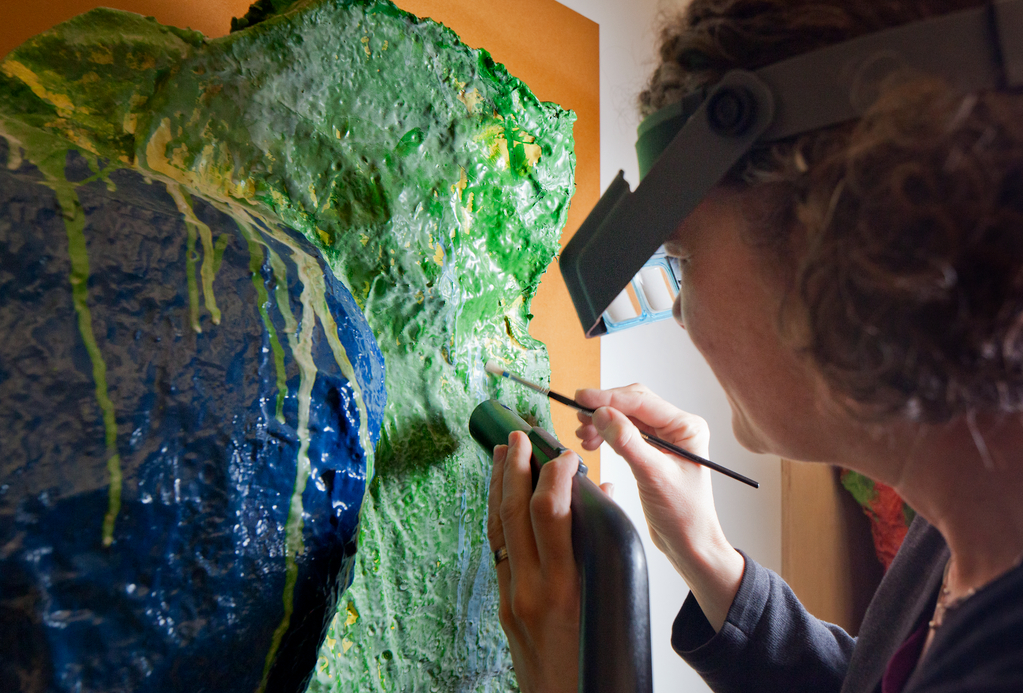
What is it like to be an art conservator? Michelle Barger, SFMOMA’s head of conservation since 2015, shares experiences from her thirty years in the field.
SFMOMA: What got you hooked on art conservation?
MICHELLE BARGER: In college my seminar class toured the National Gallery of Art in Washington, D.C., and a curator took us into conservation. On a table they had a round painting by Titian of Mary, John the Baptist, and Jesus seated in a garden and then an x-ray radiograph of it on a light box on the wall showing the compositional changes underneath the artwork. It blew my mind that this technology could exist alongside the painted masterpiece.
SFMOMA: What’s the first thing you do when an artwork comes into your studio?
MB: Deep looking to learn how the object was made, what materials were used, and how the artist manipulated them. SFMOMA’s conservation studio is intentionally one big space where conservators with different specialties can look at things together. Think of a Rauschenberg — it can have a little bit of everything. The bonus of working with contemporary art is that you can reach out to a living artist and learn directly from them. Much less sleuthing!
SFMOMA: What’s the most common misconception about art conservation?
MB: People typically think about before and after treatments — removing a darkened varnish to reveal a colorful painting underneath or reassembling shards into a ceramic vessel. But, like healthcare, much of the work we do is preventive and holistic.

SFMOMA: How has the field changed since the start of your career?
MB: When I started, few museums focused on the care of contemporary art. Conservation training programs didn’t offer it as a specialty. SFMOMA was one of the first museums to work with living artists in the care of their work — I’ve heard some animated stories of working with Bruce Conner in the early 1970s. There are many more resources available today. One U.S. training program now offers electronic media as a specialty and I’m proud to say that the first student was from SFMOMA.
Also, thankfully, people are reconsidering what qualifies a person to preserve someone else’s history. With Native American objects, for instance, someone from that population will have a different approach for care and preservation. Having a conservation or chemistry degree alone certainly doesn’t make you better qualified.
MB: Some skills we learn, others we farm out. We recently acquired Hybrida (2020) by Amor Muñoz: a bio-sculpture containing glass stomachs with kombucha growing in them. A pH meter regulates the fermentation, and sensors transform data into percolating intestinal sounds. We had kombucha fermenting in the conservation studio for a few months and our media conservator quickly became expert in feeding and maintaining the scoby. That’s a new skill! But we’re not going to learn how to re-felt the pool table in Sherrie Levine’s La Fortune (After Man Ray): 4 (1990); there are experts who help with that.
SFMOMA: What do you love about what you do?
MB: It’s very meditative. You can get in this zone and connect with an artwork in an intimate way. Sometimes you spend more time treating a work than the artist did making it. And I love problem solving.
SFMOMA: Is there something the average person can do to preserve their artwork?
MB: Light blasts things. Don’t put artwork in direct sunlight. We all want to live with our art and enjoy it, but if you’re away, think about covering that watercolor, drawing the curtains, or getting blackout shades. One of my most treasured objects is an autographed photo of Mr. Rogers. I keep it at my desk, and more often than not, it’s turned facing the wall. It’s too precious!